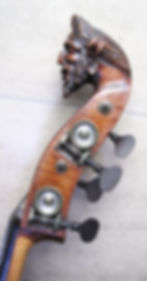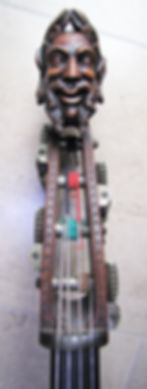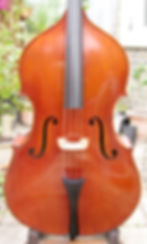.jpg)
Here we have a bass from one of the big names of 19th century English bass making, Bernard Simon Fendt Jr. (1801-1852). Having apprenticed with his father of the same name in the London workshop of John Betts, he worked with a violin dealer, Charles Farn, before setting up his own business with George Purdy.
Fendt had a reputation as an superior copyist of the finest Italian violins, cellos etc. His double bass output was prolific and he was obviously well assisted in his workshop. He essentially produced two models. Brescian and Cremonese, and this example is of the latter. Single purfled and Amati style f-holes, c.1840.
This bass has obviously been played professionally for most of it's life and has the "scars" to prove it. But it plays beautifully and would be a welcome addition to any bass section.
Length of table 113cm. String length 107cm.
£100,000

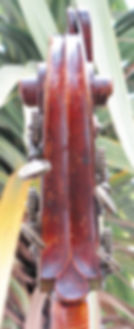
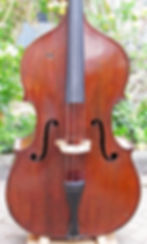

.jpg)
William Howarth (1862-1935) was born in Kings Cross, Halifax in Yorkshire. Where he spent his early life is unclear but by 1886 he was living in Newton Heath, Manchester where he married and started a large family. The 1891 Census describe William as a Pattern Maker and in 1901, a Wood Pattern Maker. This was a very skilled job and his knowledge of tools and materials would have been high. Between these two dates Howarth made double basses. Where he learned the craft is unknown but the instruments are beautifully made and, as became apparent later, he could play them too. By 1911 his profession is listed as "Bandsman". This could have been a military title or simply, a musician. Interestingly his eldest son, Herbert, is also listed with the same profession. We next meet William Howarth in 1919 on the label of an instrument made in the area of Longsight, Manchester. Professional directories of this period list him as a Musician and he appears to have stayed in this area until his death in 1935. This particular bass was made in 1899. It is a fine orchestral instrument in excellent condition. It has acquired an extra coat of varnish but in all other respects is completely original.
Length of String 106.6cm
£75,000
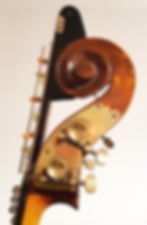
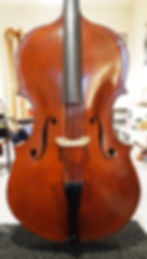


.jpg)
This instrument is not a cello, despite appearances to the contrary. It is a normal sized double bass, thought to be English, early 19th century.
The cello outline was fairly common to basses but many have had their shoulders reduced and a break put in the back to accommodate playing in the upper register. This one is as it was originally made.
The body is ever so slightly asymmetrical which leads me to think it was not made on a mould, and that makes me wonder if it was a one-off from a good cello or violin maker. The scroll, the purfling, the varnish and the f-holes are all examples of skilled workmanship.
To quote the owner, "The bass has been setup by the Thomas and George Martin Team to play Classical and Jazz music. The sound is focused, tight and projecting."
Length of table 108cm. String length 106.5cm
£60,000
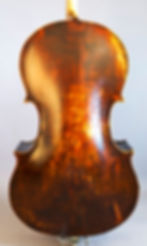

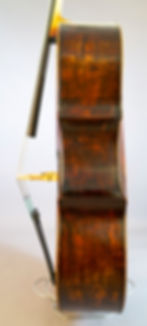

.jpg)
James Brown (1804 - 1885) lived and worked in Huddersfield, Yorkshire from the mid 1850s amd made this double bass in 1862 as is clearly stated on it's label. It was originally built with a long body but in 1965 double bass player and instrument maker Robert "Bob" Norris reduced the shoulders of the bass giving it a very manageable short scale length. A photograph of the bass in it's original form can be seen in Raymond Elgar's famous book, "Looking At The Double Bass".
This instrument has been played all over the world in major London orchestras and is very reasonably priced for sale.
String Length 99.5cm. Length of Back 113cm.
£59,000
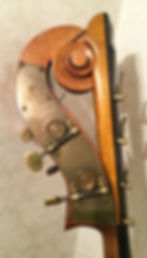
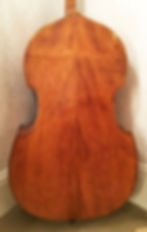


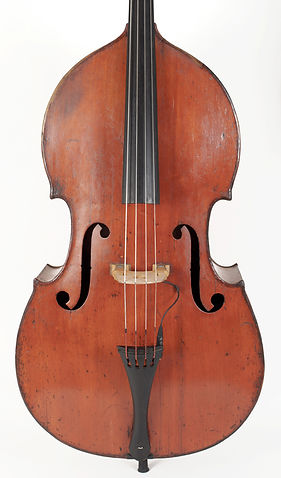.jpg)
This beautiful example of the work of Francois Pillement (1775-1820) is a very attractive prospect for any bass player. Although currently fitted with an easily removable "jazz pickup", with a bit of tweaking, an extension, and maybe a change of strings it would be a fine orchestral instrument, also.
The bass is branded,
"F. Pillement, Pere, a Paris."
But he worked in Mirecourt, and the Paris reference was something of sales ploy, by all accounts.
This acclaimed maker was a true craftsman and I highly recommend this bass.
£30,000

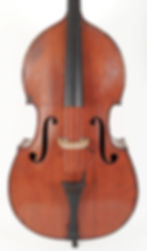
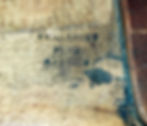

.jpg)
This fascinating instrument by William Booth of Leeds (1779-1858) has an interesting history. In the early 19th Century an amateur cellist named Barraud developed an instrument designed to be tuned as a cello but an octave lower so as to play the double bass parts in chamber music. He commissioned various luthiers including Thomas Kennedy and Samuel Gilkes to make such an instrument which became known as a Basso di Camera. The instrument featured is beautifully made and is inscribed inside with the following:
This Chamber Double Bass
Made by Wm. Booth. Mill Hill, Leeds.
In the year of our Lord 1821
for Dr. Hay of Cambridge
being the 3rd that has been known
to be made in this country.
The current owner decided that a three string configuration suited them better but all four string fittings
accompany the chamber bass, as does a 1946 William A. Chanot certificate.
String length 72.5cm. Length of Back 80cm.
£30,000.

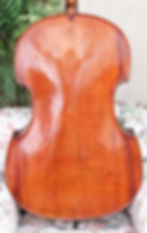
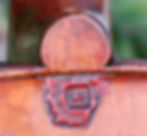

.jpg)
I have owned this double bass for many years, but it is time to sell after some brilliant renovation by Ben Wolstenholme of Woolwich, South London.
The name Jacquet is synonymous with the somewhat conventional French basses being produced in Mirecourt, France in the late 19th century. Many for export.
Gabriel Jacquet (1848-1899) was probably the finest maker of that dynasty. Known as Jacquet Gand (after his wife's family name) he signed this instrument on the inside table in pencil with a large florid script. It reads:
Jacquet-Gand
luthier a Mirecourt
1886 / (Vosges)
Length of back 114cm. String length 106cm.
£18,000
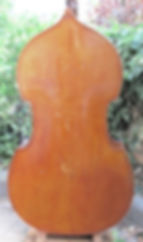
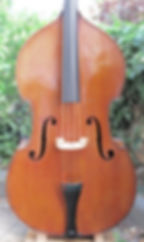
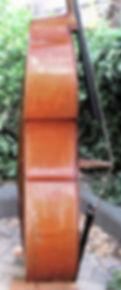


This very interesting bass was posing alot of questions to begin with. French? Probably but not typically. Age? Hard to say. And then the fascinating scroll. All became clear on discovering a name on the bass bar.
This reads M. Bruyas A St Etienne.
Maurice Bruyas was born in 1907 in the French region of Chaumont-sur-Loire. He was a violinist and secured work with the Radio and Opera Orchestras in Algiers. He also became a wood carver in some capacity and learned violin making from his uncle, an amateur luthier. He was obviously gifted as, by 1946, he had settled in St. Etienne where he was appointed luthier to the Conservatoire and, in 1949, won a diploma in a violin making competition at The Hague.
All this information leads to a double bass that is the perfect combination of Bruyas' wood carving and instrument making skills, c.1950. The rich sound and sloping shoulders of this well preserved instrument would make it an excellent solo bass, but would sound well in any situation.
Length of Back 118cm. String Length 106cm.
£15,000
